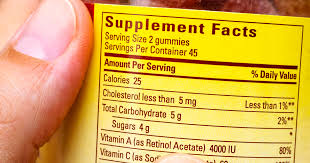Gummy vitamins- a peek into Candyceuticals!
- SUPREEMA DAS

- Jun 5, 2024
- 3 min read
Gummy supplements are dietary supplements delivered as gummy like candy, commonly comprising vitamins. They are an alternative to other supplement formulations.
The gummy supplement market is rapidly growing, driven by growing awareness of preventive care, rising cases of undernourishment in developing countries and a rise in new product offerings from both major traditional pharmaceutical companies, as well as new startups.
Most commonly, gummy supplements are made from gelatin, cornstarch, water and sugar, along with flavorings.
Since they’re loaded with nutrients, gummy vitamins may benefit some populations.
Many people consume vitamins to make sure they’re getting all of the nutrients they need.
While this is a common practice, research suggests that most people who eat a balanced diet do not need to take multivitamins.
However, some people may benefit from supplements, including those who:
don’t eat certain foods
have trouble absorbing some nutrients
have increased nutrient needs.
Gummy vitamins are designed to be a more palatable (read: sweeter) alternative to regular vitamins in the hopes that people will be more inclined to take them.
The American Heart Association recommends no more than 25 grams of sugar per day for women and no more than 36 grams of sugar per day for men — but gummy vitamins typically have 2 to 8 grams of sugar per serving, which can quickly make a dent in your daily allotment.
They can make a dent in your dental health, too: As with other sweets, the sugar and citric acid in gummy vitamins can stick to your teeth and quickly lead to cavities.
And while some gummy vitamins are made with sugar substitutes, such ingredients may present issues of their own. Sugar alcohols are associated with gastrointestinal issues and can have a laxative effect — and people who can’t consume sorbitol and similar sugar substitutes should steer clear of gummy vitamins entirely.
The FDA does not regulate supplements — so it’s never easy to determine the exact nutrients you’re getting. But the vitamins and minerals in gummy vitamins are especially tough to nail down.
Gummy vitamins have a limited shelf life when compared to traditional supplements. They become less potent with time. To address the decline, manufacturers often pack gummy supplements with more vitamins than listed. That means that newly packed gummy vitamins may have more nutrients than you need, and older containers may not have anywhere near the amount listed on the nutrition label.
It’s tempting to take more than the recommended dose of vitamins when they taste like candy. But you need to be careful because it is possible to overdose on specific vitamins, including vitamins A, D, E and K. Too much iron and zinc can also cause side effects, such as diarrhea, stomach pain and vomiting.
Common symptoms of a vitamin overdose are diarrhea and vomiting. But over time, too many of these vitamins and minerals can increase the risk of liver failure.
Powerful marketing tells us that smearing creams on our faces is no longer enough – we need to ingest ingredients that are said to defy ageing as well. Beauty sites now sell tubs of gummies alongside makeup and cosmetics. Chewy supplement makers have jumped on the hyaluronic acid and collagen bandwagons – with gummies containing these wrinkle-reducing ingredients widespread. No wonder global demand for collagen supplements is now soaring, while the hyaluronic acid market is booming.
Looks may matter but, as far as nutritional benefits go, it’s what’s inside that counts. Dietitian Sophie Medlin says most gummies fail to offer any benefits beyond traditional pills. She adds that “it’s hard to get a meaningful amount of anything into a gummy because of all the other stuff you have to put in there to make it taste OK, to make the mouth feel OK, and to make it look cool.”
Trends come and go, but this wellness craze shows no signs of slowing any time soon, despite health experts bemoaning the proliferation of ultra-processed foods (UPF).
To get the most out of gummy vitamins, take these steps:
>Read the nutrition label to ensure the gummies contain the nutrients you need and are low in sugar.
>Choose gummies that are third-party tested (look for a certification stamp) and manufactured by reputable retailers.
>Pay attention to the recommended dosage, and stick to it to avoid taking too much.
References: UCLA health/Cleveland clinic/Guardian







Comments